(1) Magazine House, Panbari, Dhubri District:
The Magazine house at Panbari in Dhubri district is in a dilapidated state. It was erected during the period of conflict between the Ahomsand the Mughals.
(2) Panbari Ruins, Panbari, Dhubri District:
Ruins of the foundation of a brick structure dateble to medieval period are to be found at the site.
(3) Moterjhar Temple, Moterjhar, Dhubri District:
A brick-built temple of the Koch period is to be found here. This site has a tank. Evidence of a brick structure of a secular nature is also found buried in the site, which is yet to be explored fully.
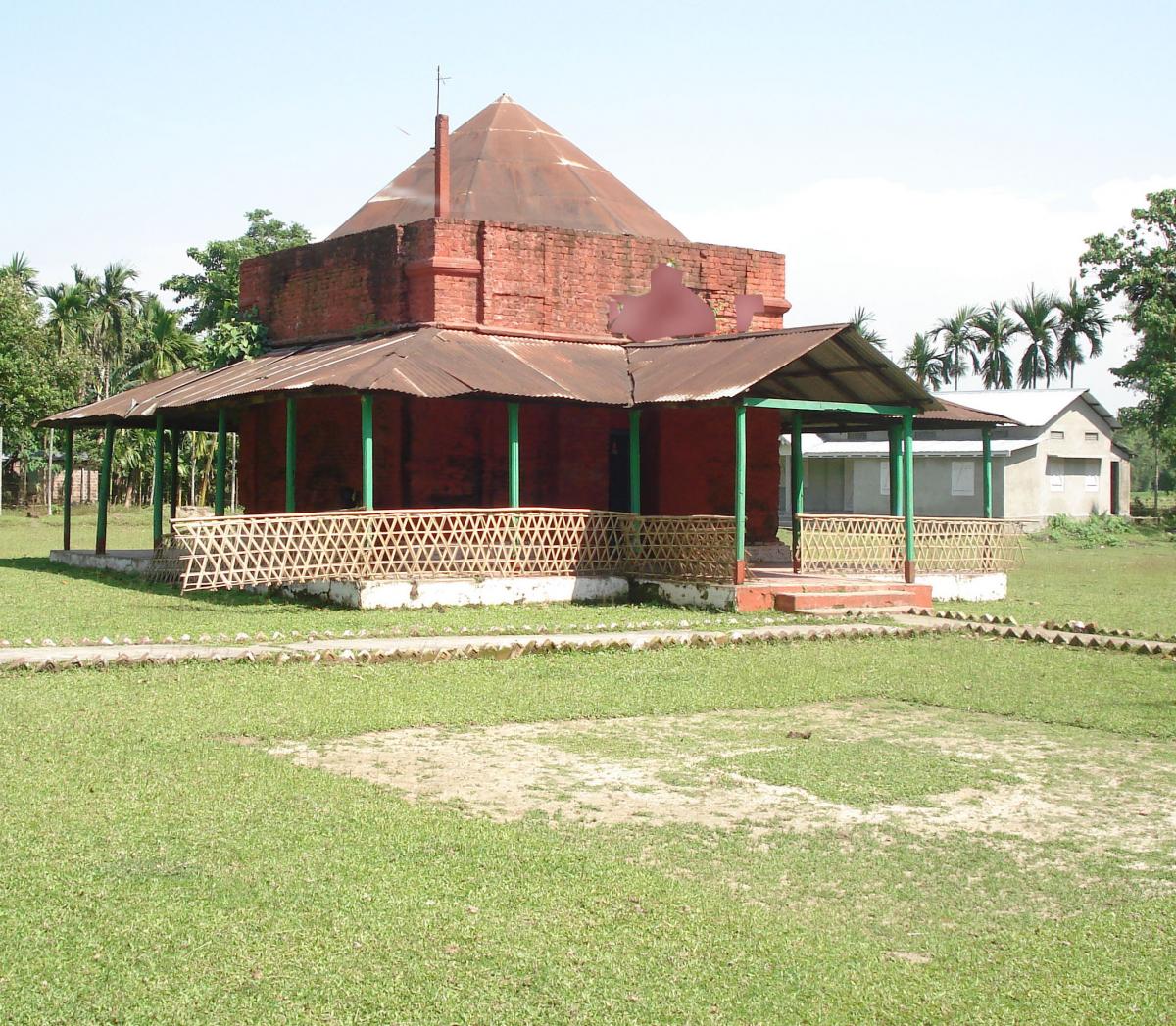
(4) Mahadev Parvat, Sri SriSurya Pahar, Goalpara District:
A great number of Sivalingas are found at this site.

(5) Paglatek Ruins, Paglatek, Goalpara District:
This site dates back to the post-Gupta period. A few gold coins thought to belong to c. 700 CE, found at this site by a chance discovery, suggest the development of this site in relation to early historical trade. Archaeological exploration done by this Directorate confirms as much.This site has a single rock-cut cave facing the river Brahmaputra. Components of a stone temple, carved temple relics and a Yonipith datable to c.1100 CE are found here.
Archaeological excavation revealed a massive brick-built wall laid out in north-south direction. The possibility of the continuity of this brick wall further south cannot be ruled out since salvage digging in the hillock revealed traces of brick structures in the southern Paglatek hills adjacent to the site. Since gold coins of c CE 700 were found here, the relevance of the explored evidence could be visualised from the point of view of trade of which Paglatek was once a seat. This site also has a living Siva temple and thus it follows that Sivaratri is the prime religious festival of this site. Innumerable visitors come to this site regularly and especially throng here on religious festivals.

(6) Raush Monument, Kachari Road, Goalpara District:
The Raush Monument is the graveof an European salt trader located at Bandar Kanda hillock near the Court of the Chief Judicial Magistrate in Goalpara. The hillock has a unique location surrounded as it is by the River Brahmaputra on three directions. It housed a colony of British and other European officials- the existence of several graves and evidence of British buildings point towards that. The graves commemoratethe glory of the British officials who had controlled administration from this locality in Goalpara.
(7) Tukreswari Temple, Krishnai, Goalpara District:
A Siva linga is to be found at this site. A modern temple with a corrugated iron sheet roof now exists at its foot. According to popular lore, a part of Sati's body fell here.
(8) Siva Than, Pancharatna, Goalpara District:
Here exist archaeological ruins of different cultural periods. The rock-cut stupa is stylistically datable to the pre-Chrstian era. The architectural components of a stone temple scattered at this site can be stylistically dated to c. 10th -11th CE
| | |
(9) Ganesa Mandir, Abhayapuri, Bongaigaon District:
The Ganesh Temple Archaeolocial Site has a ground plan and remains of a stone temple of Ganesa surrounded by a raised brick built platform with a floor. The brick plinth is typically triratha in plan. Laid out in north-south direction, it is 32 m in length. The width of the brick plinth is 19 m in middle and 14 m each- both in the northern east-west and southern east-west margins. It was exposed to 15 courses of bricks in the south and 20 courses of bricks in the north, the thickness of brick measure being 0.5m. The ground plan of the stone temple of Ganesa has two parts -the garbhagriha and antarala. The plan of the mandapa of the temple has not been found. The plan of the garbhagriha and antarala of the temple is 6.3 m in all directions. The site has numerous stone temple fragments. These are preserved in three archaeological site galleries and include amassive stone door frame decorated with a naga and a human figure with large ears (to depict Ganesa), amalaka(a ribbed stone building component), a bow frame-like carved jali work (lattice) in stone, part of a door frame, a pillar base with carvings of elephants trunks and others.Carved panels of sculptures and a figure of Ganesa from this site are preserved in the modern temple built nearby.
(10) Kakaijana Archaeological Site, Kakaijana, Bongaigaon District:
There is evidence of bricks exposed on the surface, a Sivalinga and a Yonipith at this site.
 | 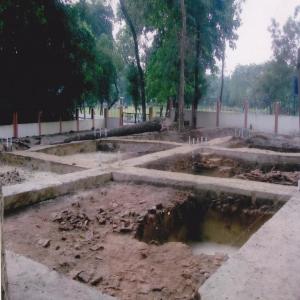 |
(11) Billeswar Temple, Belsor, Nalbari District:
Billeswar Temple is built of brick over the foundations of a stone temple. It has a stone inscription proclaiming a land grant for the maintenance of the temple by the Ahom King Siva Singha (1714-1744 CE). The site has a tank and theground plan and elevation of the temple is north Indian in style.
The outer wall of the temple is decorated with a number of sculptures modern in appearance. Thegarbhagrha of the temple is now sunk and its Sivalinga and Yonipitha remain submerged throughout the year owing to the raising of the level of the ground around the temple. A modern mandapa has been built to accommodate the local populace that throngs it during Sivaratri and Durga Puja- two religious festivals of prime importance that this community holds dear.
(12) Balilecha Kali Mandir, Nalbari, Nalbari District:
Ruins of two brick built temple exist here. One of them enshrines an image of the goddess Kali, built during the Ahom period.
(13)Ambari Archaeological Site, Ambari, Kamrup (M) District:
The Ambari Archaeological Site was discovered in the year 1968. Material evidence unearthed during the course of excavations has established that the site was one of the important centres of culture that flourished in ancient Kamarupa. The settlements of the site are broadly assigned totwo cultural periods. Of these, the early cultural period flourished as an urban centre fromBCE 200 while the later cultural phase after a brief cultural gap continued from c. 1100 CE to the late mediaeval period.
Major structural remains of the early phase are comprised of the remains of a tank of burnt bricks followed by a drainage system, brick-paved pathways, brick-paved floors and foundation walls of the early mediaeval period. These features suggest the development of Ambari as a cultural centre on the river Brahmaputra flowing to the north. During the early mediaeval period the site functioned as an artist's guild and a production centre of sculptures (atelier) with its distinct artform often termed the Kamarupa School of Art.
The discovery of a large number of stone sculptures, Siva lingas, terracotta, kaolin pots, oil lamps, sculptures, and other antiquities like beads and ornaments make it clear that the site was an atelier and artists and sculptors dwelt in this site leading. The sculpture of Nataraja on the vahana Nandi found here is unique in this country and was a production of local iconographical norms.
Scientific clearance directed for structural conservation of the brick architectural remains during 2002-03 revealed existence of a square structure, which was a living apartment divided by an inner corridor laid in north-south direction. This dwelling apartment was found laid within a north-southern and an east western brick wall. Innumerable stone sculptures of various divinities of Brahmanical faith and terracotta human figurines are now preserved in a museum in situ and at the Assam State Museum. The structural remains of the later phase are not so distinctive but evidence of some remarkable ceramic wares like glazed terracotta potteries, kaolin pots and celadon wares found in the site indicate that the site perhaps served as an important centre for trade since ancient times. This is confirmed by the discovery of a terracotta clay sealing and evidence of a brick-built tank datable to the Sunga-Kushana period of ancient Indian history during excavation conducted in the site in 2008-09.
 |  | |
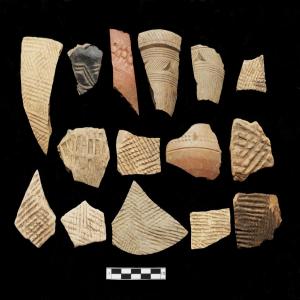 |
(14) Umananda Temple, Umananda, Kamrup District:
The Umananda temple is situated on the Umananda Island in the midst of the river Brahmaputra. In Pauranic mythologythe island is known as Bhasmacala. Evidence ofa stone temple belonging to the post-Gupta period can be seen on the site. The site has stone sculptures and carvings belonging to the early mediaeval period. Achaturbhuja stone female figure still exists here besidesrock cut figures of Ganesa and a cave. Named as Peacock island by the British, the site is in the northern direction of the Office of the Deputy Commissioner, Kamrup district. There are three temples on this river island. The earliest was built towards the close of the 17thcentury CE. The two other temples belong to the early 19th centuryCE.
The Ahom king Gadadhar Singha (1681-1696 CE) erected a brick temple dedicated to Lord Siva on top of the existing stone structure of the earlier period. There exist two otherbrick temples-theChandrasekhara temple, believed to be built in 1820 CE by the Ahom King Chandrakanta Singha and the Hara-Gauri temple of the contemporary period, built by Gaurinath Singha.Of these three, the Umananda temple is the oldest and tallest and an inscribed silver image of Siva is worshipped inside it.
The Chandrasekhar temple is octagonal in plan and has a Siva linga. Architecturally, the Umananda temple is a pancharatha temple of the rekhadeul variety but it is without any angasekhara. Both the temples are surrounded by a brick boundary wall. The Hara-Gauri temple is at the outer entrance to the Umananda temple. It is a small shrine. Located as it ison an island, the Umananda temple has unique riverine beauty. This temple is considered as one of the five panchatirthas in Guwahati.
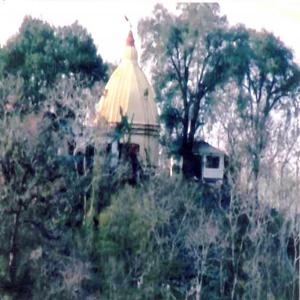 | | |
 |
(15) Chatrakar Temple, Uzan Bazar, Kamrup (M) District:
The site located on devottar land has a group of three temples dedicated to Siva, Visnu and Mangalchandi of the late mediaeval period. Built during the reign of the Ahom king Kamaleswar Singha, (1795-1810), the Chatrakar temple is an important saktashrine. A few stone sculptures of the stone temple that existed on this site during the early mediaeval period are found here. A few sculptures of the early mediaeval phase have been embedded in the outer walls of the temples. A beautifullycarved stone image of Vamshigopalais enshrined in the Visnu temple here. These temples have been renovated in recent years. Situated on the hillock facing the river Brahmaputra in north, this is a place for pilgrimage for devotees amongst other regular visitors.
| |
(16) Manikarneswar Temple Archaeological Site, North Guwahati, Kamrup District:
Manikarneswar temple is in devottar land located at Manikarneswar hill in North Guwahati facing the river Brahmaputra. This is a late mediaeval brick Siva temple erected upon the ruins of an early mediaeval stone temple, the plinth of which is found to be star - shaped with its vimana which is twelve sided. Upon this stone temple plinth a brick temple dedicated to Lord Siva was erected during the late mediaeval period. The temple is broken and the sikhara part is no longer in existence. Stone sculptures of an earlier period are found set on the outer walls of the temple. The brick-built mandapa of the temple renovated in the year 2005, has a horizontal panel of sculptures at bottom and vertical lines of floral and decorative arrangements.
The temple has an amazing location surrounded by the river Brahmaputra. The scenic view of the large sheet of water of the Brahmaputra, visible on three sides of the hillock makes it aesthetically unique. Besides the panoramic view of the distant hills, a glimpse of the southern part of Guwahati city and the tranquillity of the site turn the spot into a resort of idyllicbeauty.
(17) Kanai Borosibowa Rock Inscription, North Guwahati, Kamrup District:
The site has three rock cut inscriptions, a rock-cut geometrical design and a rock-cut figure of Ganesa. The earliest of the three inscriptions records invasion of Kamarupa by the Turks in 1205 CE. The other two inscriptions datable to the 17th century CE refers to a battle of the Assamese army with the Mughals. Of these records of the site, the first inscription i.e. the Kanai Borosibowa Rock Inscription is engraved upon a rock situated at a lower level in the eastern part of the site. The other two are engraved upon a huge rock in the middle of the site. The former record known as the Kanai Borosibowa Rock Inscription is engraved in the Assamese and Devnagari script and is considered to be the earliest specimen of an Assamese inscription. The date of the record is narrated in symbolic expression and not in figures as follows:
Sake Turaga-Jugmese Madhumasa-Trayodase Kamarupang samagatya Turuskah Kshayamayayuh.(In the Saka Era 1127 (1205CE) the Turks coming into Kamarupa were totally annihilated).
(18) Asvakranta Temple Archaeological Site, North Guwahati, Kamrup District:
The site is situated on devottar land and has two temples of Visnu and two rock-cut caves facing the river Brahmaputra. Of these temples, the one located at the lower level of the hillock is known as Kurma Janardana temple and the other at the hilltop is known as Asvakranta temple or Anantasayi Visnu temple.
Both temples are erected upon the remains of two earlier stone temple plinths. The Aswakranta or Anantasayi Visnu temple at the hilltop is triratha in plan and has a mandapa. This temple has figures of the dasavatara forms of Visnu on the outer walls and a few others in the inner walls of the mandapa. The figure of Anantasayi Visnu is housed in the garbhagrha of the temple.
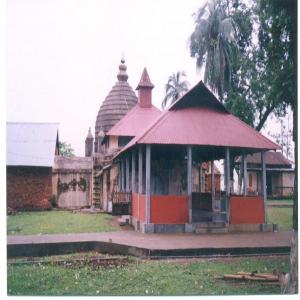
(19) Dirghesvari Devalaya, North Guwahati, Kamrup District:
The site is known for its rock-cut sculptures of Ganesa and for a brick temple dedicated to the Goddess Dirghesvari or Durga. The Dirghesvari temple is a saktipith of Goddess Durga situated on the Dirghesvari hill. The site has evidence of earlier stone structures which can be reached travelling along a stairway. The hewn marks of steps in rocks are still in existence. The site has a number of rock-cut sculptures and of these, a rock-cut figure of Ganesa is believed to be the largest in Assam. These rock-cut figures are datable to c. 1000 -1100 CE.
The Ahom King Siva Singha (1714-1744 CE) built a brick temple on the site. The brick built torana of the temple with an inscription embedded on it and evidence of the brick boundary wall stand as theonly evidence of the brick-built temple that existed on this site. The Dirghesvari hill being an elongatedrange and its rock base touches as it does the River Brahmaputra, yield a panoramicview of the riverfront. A small hilly stream perennially flowing by the temple further adds to the tranquilcharm of this site.
| | 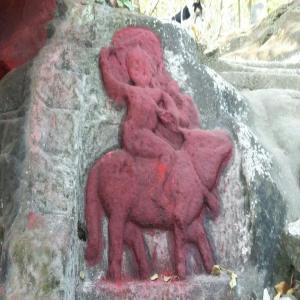 | |
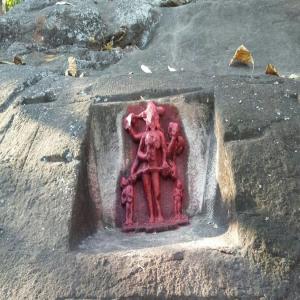 | 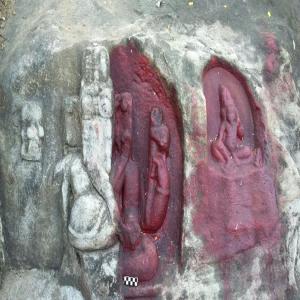 | 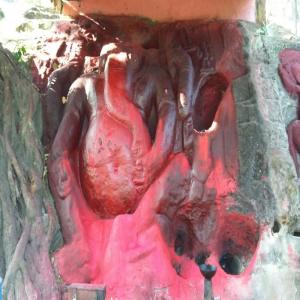 |
(20) Chilating Rock Inscription, Gauripur, Kamrup District:
This inscription exists at the foot of the Chilating hill on the National Highway No 31. Engraved in Assamese and datable to c.1734 CE, itrecords theexcavation of a moat (garhkhawoi).
(21) Rudreswar Temple, North Guwahati, Kamrup District:
This is a late mediaeval Siva temple on devottar land, consisting of two separate structures, viz. a raised square platform and a temple with a mandapa restingupon the platform. The ground plan of the temple is square and includes an inner passage as pradakshinapatha.The upper storey has a temple with an openpradakshinapatha surrounding the sikhara. This structure recalls a Mughal-styled mausoleum. The stylistic feature of this structure primarily lies in its composite form as a temple and a mausoleum. A stairway is provided from the ground level that leads one to the upper storey where the temple exists. The upper story is surrounded by an open space for performance ofpradakshina around the temple.
The structure is a smaller mausoleum with a temple and is the only temple architecture of its kind in Assam.The sikhara of the temple is however no longer in existence. This temple was built by the Ahom king Pramatta Singha (1744-1751 CE) in memory of his father Rudra Singha (1696-1714 CE), who died at this location.
(22) Chandrasekhar Temple, Umananda, Kamrup District:
This is a brick-built temple constructed by the Ahom king Chandrakanta Singha in c.1820 CE.It is a miniature shrine. The ground plan of the temple is square-shaped and the sikhara of the temple is an octagonal dome with a number of horizontal mouldings. This temple is situated close to the main temple of the site dedicated to Uma Maheswara.

(23) Hara-Gauri Temple, Umananda, Kamrup District:
A brick-built miniature temple of the Ahom period located in devottarland is to be found near the Umananda temple. This temple has two decorative mouldings -one at the pabhaga and the other at the bada.
`+
 |  |
(24) Na-Math, Kamakhya, Kamrup (M) District:
This is a squarish brick-built terracotta temple on devottar land enriched with carvings of terracotta sculptures and floral designs. This is the only existing terracotta temple so far in Assam. The Ahom king Siva Singha (1714 - 1744 CE) became a disciple of Krishnaram Bhattacharyya, who was given the management of the temple of Kamakhya. Krishnaram and his successors, generally known as Parbatiya Gosain, were assigned large estates of land for the maintenance of this temple. This temple was erected for the private worship of the Parbatiya Gosains by the king.
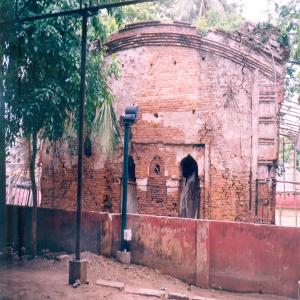
(25) Umachal Rock Inscription, Nilachal hill, Kamrup (M) District:
Umachal Rock Inscription is located on Umachal in Nilachal hill facing the River Brahmaputra. This rock-cut inscription is engraved in brahmi as follows:
This cave (temple) of the illustrious Lord Balabhadra has been constructed by maharajadhiraja Sri Surendra Varmana
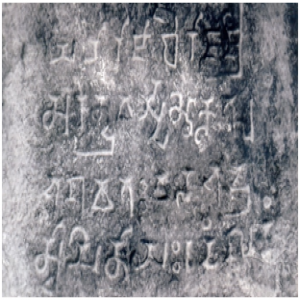
(26) Persian Rock Inscription, Kamakhya, Kamrup (M) District :
This Persian Rock Inscription is situated at the lower level of the Kamakhya hill, near the brick-built entrance that leads to the historical stone stairway of the Kamakhya temple. This is a short rock-cut inscription in Arabic script, engraved in two lines in letters datable to the late mediaeval period. It reads: sar-e- khijar lab-ye- hayat, translating to:
"A prophet who the shows path to the pathless is alive(here)"
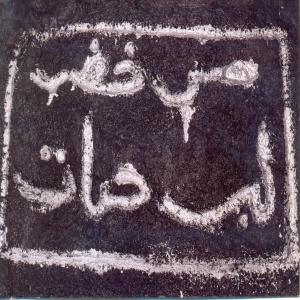
(27) Pingaleswar Archaeological Site, Karara, Kamrup District:
The site is located on devottar land and has evidence of a stone temple belonging to the early mediaeval period. Over the foundation of the stone temple a modern temple has been built. Stone temple sculptures, fragments of door jambs, pillar capitals, carved panels of sculptures depicting things such as players of musical instruments, dancing figures, lotus designs, erotic art forms and other temple relics and a stone inscription are found on this site. The Pingaleswara temple was richly ornamented as reflected from its decorative components and carvings from the pabhaga of the temple. Frieze and bracket figures,apart from several angasikharas of the temple are to be found here. Sculptures and temple relics date back to c. AD 1000. A gallery and a site museum have been set up here with sculptures and temple relics of the site. Siva is worshipped here in the linga form and revered as Pingaleswara in this site.
(28) Chandar Merghar Archaelogical Site, Chhaygaon, Kamrup District:
Chandar Merghar Archaeological Site has ruins of stone temple architectures of two different periods- 11th-12th century CE and the other (probably of),the 16th -17th century CE. A modern temple erected upon the old structures enshrines a Devi image and a Sivalinga in a large round sunken sanctum carved out of stone masonry. The site has a tank.
An archaeological site-museum and a park with stone temple relics collected from the site have been set up here. Notable among these are stone door frames, sculptures of Ganesa, lotus erotic sculptures and other stone components such as amalaka and gargoyles of the temple. Popular belief associated this Merghar Archaeological Site with the legend of Beula Lakhindar and Chand Sadagar of the Padma Purana.
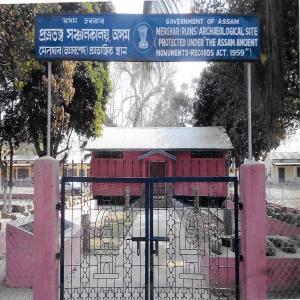 |
(29) Siddheswar Temple Archaeological Site, Sualkuchi, Kamrup District:
The Siddheswar temple of Sualkuchi is situated on devottar land and dedicated to Lord Siva. It is a brick-built Siva temple situated upon a hillock. This temple was rebuilt upon the pabhaga of an early mediaeval stone temple during the reign of Swargadeo Siva Singha in 1722 CE. The temple is situated on a hillock surrounded by a dead river in three directions and by the River Brahmaputra on the south. Archaeological evidence of a stone temple of early mediaeval period datable to c.1100 CE exists here. Stone sculptures and temple relics of this period are reused as decoration for the outer face of the walls of the temple. With the displaced stone temple relics of the early mediaevalperiod, a stone stairway leading to the temple has been built in the southern direction by the Ahom king. It seems that the temple originally was pancayatana in plan with a Siva linga in the centre. Of the other images, figures of Durga, Visnu and Surya have been found on the walls of the temple. The figure of Ganesa which ought to have been there is now missing. The temple has a bricktorana and is surrounded in all directions by old brick-built walls.
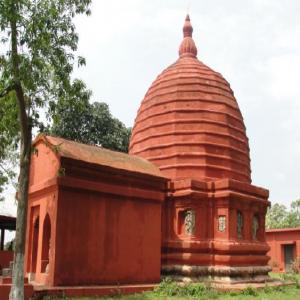
(30) Madan Kamdev Archaeological Site, Baihata Chariali, Kamrup District :
The Madan Kamdev Archaeological Site has several stone temples spread over an area upon a hillock known locally as Madan Kamdeva hill. It is surrounded by the dead course of a stream known as Madan Kuri which still flows to its south. The site has a beautiful natural environment enriched by native flora and fauna. Amidst such grandeur lies Madan Kamdev in all its glory that once flourished as a socio-cultural centre. A remote name of Madan Kamdev temple was Hara Gauri-Kameswara. The presiding deity of the temple site is Uma-Maheswara enshrined in alingana posture in the garbhagriha of the principal shrine. There exists a plethora of temples, the ground plans of which are found laid in east-western alignment on the site. These temples however are miniature shrines now found only with their lithic ground plans of mandapa with garbhagrha.
The principal shrine is pancaratha in ground plan. It has a rectangular mandapa. The temple is in ruins and exists upto the plinth level. The temple architecture is rich in ornamentation and a panel of amorous sculptures, sculptural forms of both human and animal life followed at bottom by a panel of Kirttimukha adorns the outer surface of the garbhagriha.Sculptures, floral designs and temple relics have been found in the site. Sculptures of divine and semi divine figures, both in sthanaka and asana varieties have been found. Fragments of angasekhara,dhawaja-sthambha and other sculptures of the site indicate that the temple had immense beauty when it was intact. A three-faced female figure-a Brahmani-seated on a corpse and being surrounded by jackals and other animals, point towards the development of the native tantric belief of kaula-kapalika cult in this site. The outer face of the garbhagriha of the temple is adorned with panels of scenesof erotic life. Judging by its style, the site dates back to the c.1000 CE
(31) Karbi Memorial, Dakhinbam, Sonapur, Kamrup (M) District:
The Karbi Memorials Site contains a good number of monoliths in a single seat. These have been erected in memory of the dead as per the Karbi tradition of worshipping the souls of the dead for earning piety and prosperity in life.
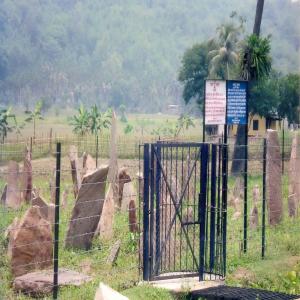 |
(32)Vasistha Temple, Guwahati, Kamrup (M) District:
This is a brick temple built during the reign of the Ahom King Rajeswar Singha (1751 - 1769 CE) in c. CE 1764. The site has evidence of a stone temple which once stood at this spot around 1000-1100 CE A brick temple has been built upon the remains of the stone temple of an earlier period. It is an octagonal temple with a polygonal sikhara over it. The temple has a sunken garbhagriha which is believed to have the foot impression of the sage Vasistha, who is believed to have had his asrama in this area in the remote past.
Vasistha temple is located on a small hill known as Sandhyachala in the southern extremity of the Guwahati city. The site has a hilly topography with fast streams flowing along the site. The temple stands on the confluence of three hilly streams called Sandhya, Lalita and Kanta. As such, the site has unique natural beauty.
(33) Bhairabeswari temple, Rangia, Kamrup District:
Remains of a stone temple datable to c. 1100 CE lie here on the bank of Harhariya Jan, which flows by the spot where it once stood. Temple relics including sculptures of the period are found on the site. The site also has a large tank which is a dwelling place for seasonal migratory birds. Thus Bhairabeswari temple is a site known for both cultural and natural glory.
(34) Nazirakhat Archaeological Site, Sonapur, Kamrup (M) District:
The Nazirakhat Archaeological Site is known historically as Ganesh mandir, as this site possibly had a stone temple dedicated to Lord Ganesa. This site has ruins of a stone temple belonging to the late mediaeval period. The temple was erected on the bank of the Karchiya river and numerous stone fragments and temple components are to be found on this site, including two rock cut sculptures of Ganesa. The geographical location of the Nazirakhat Archaeological Site is one diversified by hills and plains and altogether generates an environment of natural charm enriched with cultural heritage.
 | |
(35) Bagheswari Peeth, Mirza, Kamrup District:
Here exists a rock-cutGanesha of the mediaeval period, along with architectural components of a stone temple datable to 10th -11th CE
| |
(36) Kajalichaki Archaeological Site, Chandrapur, Kamrup (M) District:
Kajalichowki is a historical site that yields evidence of the fortification of dykes, ramparts, ditches and a mound located at close proximity to the confluence of Kolong and Brahmaputra, datable to the mediaeval period.
| |
(37) Baman Ruins, Bamangaon, Darrang District :
The Baman Archaeological Site is located on a small hillock facing a dead water stream on Baman pathar. The site has ruins of a stone temple-saptaratha in ground plan. The garbhagriha of the stone temple is lotus-featured, complete with a stone pranala.The plinth is 5.71 m in all directions. The ground plan of the garbhargriha is squarish and its cruciform pattern is stylistically obvious. The temple pranala of the garbhagriha with its groove is set in the temple plinth.The squarish garbhagrha is fashioned like a bloomed lotus. The lotus-featured garbhagrha mayindicate that the temple was dedicated to Goddess Devi. A modern temple has beenbuilt over the mandapa in recent years at Baman Archaeological Site. Numerous stone temple relics, sculptures, stone columns, components from the sikhara of the temple are found here.
(38) Narikoli Ruins, Khandajan, Darrang District:
Remains of a stone temple exist on this site, over which a new temple has been built.
| | | |
(39) Rudreswar Devalaya, Maharipara, Darrang District:
A Temple enshrining a Sivalinga exists here, datable to 10th – 11th century CE
(40) Jaljali Archaeological Site, Jaljali, Darrang District:
A stone temple datable to 10th-11th century CE is to be found here.
(41) Jorpukhuri Ruins, Hatigarh, Udalguri District:
Ruins of a stone temple lie here. Most of the stone blocks are carved with geometric and floral designs, as are sculptures of human and animal forms. A pair of large tanks exists at this site from which the name Jorpukhuri in Assamese is derived.
The site covers an area of 100 x 140m and remains of a stone temple datable to c.1100-1200 CEare found on the site. The remains are mostly fragments of the stone temple. No individual sculpture now exists at this site. A carved panel depicting human figure, carvings of angasekhara, broken pillar capital, doorsil, among others are also to be seen here.
(42) Tamreswar Archaeological Site, Khairabari, Udalguri District:
Tamreswar Archaeological Site associated with a historical tank contains stone temple relics of one or more Siva temples, which is surrounded by a brick reinforced wall. Some of the stone relics are exquisitely carved. A garbhagriha with a Sivalinga exists at the site. The site seems to have had a brick-built mandapa with a floor of stone. The locality has several historical tanks such as Jabara Pukhuri, Padu Pukhuri, Bagamala Pukhuri, Ghanta Pukhuri, Khama Pukhuri, Thavaibari Pukhuri, Bherbheria Pukhuri, Sindhu Pukhuri, DewanPukhuri, Kodaldhowa Pukhuri, Chita Pukhuri among several others. In theeast of the site lies evidence of a once-flowing stream Dudra.
This area is inhabited by the Bodos since times immemorial. The term Tameswar seems to have originated from thamiswar, which means three gods in the Bodo language. These three presiding deities are- Rangraci, Gohouraci and Mitharaci identical to Brahma- Visnu - Mahesvara. Stone temple remains, scroll pattern of floral designs, parts of door frame, amalaka, carved horizontal lotus, stone foundation of the garbhagraha and numerous other stone temple relics exist here. A site museum has been built up in situ, to preserve the stone temple relics and sculptures in 2004 -2005. Religious ceremonies such as Siva Ratri, Basanti Puja and Deul Utsav during Bohag Bihu are observed here.
(43) Sculptures at Chummery Compound, Tezpur, Sonitpur District:
Here lay installations of stone sculptural relics collected from different sites. (These relics have now been shifted to Cole Park).
(44) Biswanath Temple, Biswanath Chariali, Sonitpur District:
A brick-built temple belonging to the mediaeval period exists here. This is a temple structure located in devottar land with a squared cruciform ground plan and elevation up to its sikhara. The templeis enriched with terracotta carvings. This temple was erected by the Ahom king Gadadhar Singha (1680-1696 CE) and belongs to the early phase of the development of Ahom temple architecture in Assam. A modern spacious namghar has been built to the west of the temple.
Three lines of decorative terracotta plaques adorn the outer walls of the temple. The facade of the temple is built of stone and a stone door frame bearing floral carvings adorns its trance.On the third day of the Bohag Bihu festival, the metallic idol of Biswanath is taken out of the temple to Bhargaon in a procession and brought back to the temple. Towards the end of the ceremonial procession bringing the Lord, the entire community divides into two groups-one loyal to Biswanath and the other to the Devi. The entry of lord Biswanath to the garbhagriha of the templeis resisted by the supporters of the Devi group.The God is allowed to enter the temple only after completion of a number of forceful circumambulations. This occasion is celebrated every year holding fair and social congregation.
(45) Christian Cemetery, Kalabari, Sonitpur District:
The Christian Cemetery of Tezpur was earlier known as the European and Indian cemetery. In the year 1974, this cemeterycame to be known as the Christian Cemetery after the death of the last European Missionary, Rev. Father Wyld. The total number of European graves recorded here are 75. Of these, only 37 exist today. There are Indian graves. One of the most important graves in the cemetery is that of Charles Alexander Bruce (1793 -1871 CE), who discovered the indigenous tea plant in Assam. There also exists a war memorial column dedicated to the memory of the British andAssamese soldiers who laid down their lives in the Anglo-Burmese war of1826. From an epitaph with a burial date of the grave of Mary Elizabeth,the cemetery can be dated back to 1827 CE. In 1835, the British Headquarters of Darrang District was shifted to Tezpur. Now, the Christian Cemetery of Tezpur has turned into a historical legacy of British Administration in Assam.
(46) Vasudev Doul, Kalabari, Sonitpur District:
Vasudev Doul is a brick-built Visnu temple belonging to the Ahom period. The temple is 20 m in height. A metallic idol of Vasudeva is worshipped here. It is a pancaratha temple with a kalasa having five round discs. A tank is attached to the temple. The broken mandapa of this temple was renovated in the year 2005. Besides religiousceremonies, every year during Bihu the neo-Vaisnavites assemble in the yard of this temple to celebrate it. The performance of Mukali bihu, a typical open Bihu dance in groups by boys and girls separately, is very popular here, a rare event in present times.
(47) Garhdoul Archaeological Site, Kalugaon, Sonitpur District :
The remains of a fortified area having brick ruins of temples characterises the Garhdoul Archaeological site. It has remains of a brick structure in the form of two mounds. The brick structure was erected upon a brick platform.The site has a brick reinforced fortification-250m in all directions. Situated towards the north of Dah Parvatiya Archaeological Site, Garh Doul Archaeological Site has considerable importance.
(48) Bamgaon Ruins, Biswanath Chariali, Sonitpur District:
This an archaeological site bearing evidence of brick temple belonging to the early mediaeval period. A modern Vaisnava namghar has now been constructed on the site. The site was excavated in the years 2002-03 and evidence of temple structure datable to c 800 - 900 CE was unearthed. Ruins of brick built structures exposed through excavation have been found with sculptures and terracotta objects. The exposed evidence includes brick fragments depicting birds, floral designs, human and animal figures, brick used as corner pieces and other terracotta art objects.

(49) Nandikeswar Devalaya, Jamugurihat, Sonitpur District:
Nandikeswar Devalaya located on devottar land is a brick temple built by Swargadeo Rudra Singha (AD 1696-1714).The temple was rebuilt in brick upon the stone foundation of the earlier temple. This is a rekha deul variety of temple with groundplan of the ratha projection. The present height of the visible stone plinth in the garbhagrha is 8 m. The temple is surrounded by a brick boundary wall measuring 17.5 m in the east and 50 m in the north and south. The height of the wall with 70 cm width is 1 m. A number of stone temple relics of early mediaeval period are found lying in the campus of the temple. These include:
(1) Bottom part of a stone door frame
(2) A female figure standing on an animal figure and
(3) Dwarapala holding a gada in left hand.
It is possible that there were several other stone fragments of this temple. The stone temple has its original stone door frame facing west. It measures 160 cm in height 60 m in width.The garbhagriha has a pith of linga and four pillars of stone.
The temple is sinking with the garbhagriha now sunk upto 6 feet.
(50) Surya Image, Golchepa, Sonitpur District:
The site has a brokenchaturbhuja sculpture of Surya. The sculpture has been preserved in a shed in situ.The sculpture is datable to 1200 CE.
(51) Rock Inscription, Burha Mayong, Morigaon District:
This site is located on an ancient course of a river and has a rock-cut inscription engraved on the outcrop of a rock facing Mayong Kolongmukh Road. This group of inscriptions has six lines on the left, fifteen lines in the middle and five lines on the right, placed horizontally and appears to contain three inscriptions in series. The inscriptions measure 395cms in length and 112cms in breadth. Each of the inscriptions measure 85cm x 47cm, 40cm x 112cm and 270cm x 30cm respectively. The contents of the inscriptions are yet to be deciphered and are probably datable to the medieval period.
| |
(52) Silchang Archaeological Site, Silchang, Morigaon District:
Several dolmens exist at the site. These are revered as seats of local Tiwa Chief, Village Headman and other men of status in historical Tiwa society. These serve as evidence of a lingering tradition of monolithic erection among the ethnic community of the Tiwas of Assam. This site treasures the traditional seats of stone for Dehaja, Senapati, Dekaraja, Bhai Taumaji, Montradata, Deori, Lakhipuriya, Choudang. Atleast 12 generations of Khola Deo Raja till today are known to have performed royal administration on social, political and community life of the Tiwas from this site.
(53) Matharbari Archaeological Site, Baropujia, Nagaon District:
Matharbari Archaeological Site has remains of a stone temple. A shrine was erected long ago on this site. The temple relics are datable to c.1000 CE. This site also houses a tank.
| |
(54) Rajbari Group of temples, Rajbari, Nagaon District:
Rajbari Archaeological Site is a group of at least nine Siva temples enclosed within a massive brick-built boundary wall.Both stone and bricks are found employed as building material in raising the temples. Concentration of these temple structures altogether converted this site into a complex of nine temples. Of these, three temples had been built of bricks using stone for doorframes, pillar bases and columns. The ground plans of three of these brick-built temples have been excavated and conserved from 2003-04 and 2005-06. Upon the garbhagrha of two temples modern structures have been raised enshrining in these a Yonipith and a Uma - Maheswara respectively. The other temple plinth has a garbhagrha raised of stone.The site has numerous stone temple relics stylistically datable to 11th century CE.
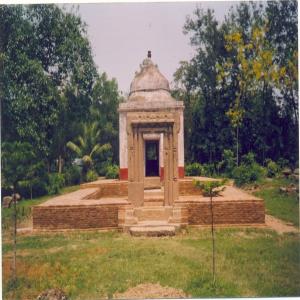 | 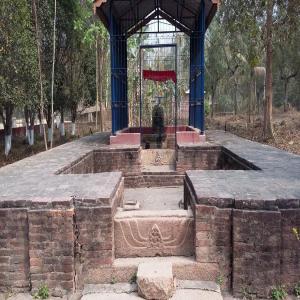 | 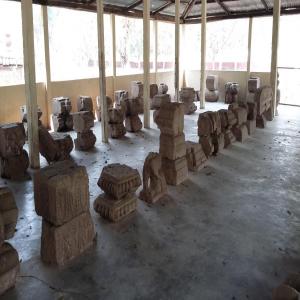 |
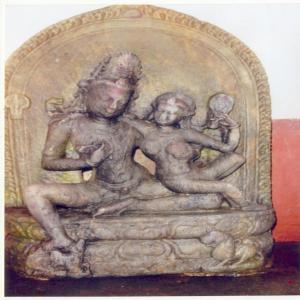 |
(55) Sankhadevi Archaeological Site, Jogijan, Nagaon District:
Shankhyadevi site has a group of temples, located on Jogijan, a small tributary of the Kapili river. The site has three mounds containing remains of three stone temples. Of these, one mound has been salvaged and stone relics ofa temple dedicated to Devi Durga have been unearthed. The remains include fragments of a massive stone door jamb with carving of a figure of Durga in the upper central part of the door frame. Doorjambs,carved stone,pranalafrom garbhagriha, doorsils,lintels, pillars and numerous other carved temple relics are found in this site. Numerous fragments of stone temples are scattered everywhere. The two other mounds are undisturbed. The site has a stone stairway leading to the river indicating earlier communication that was maintained through river to the temples of this site.
| |
(56) Mahadeosal Archaeological Site, Mahadeosal, Nagaon District:
Mahadeosal Archaeological Site has structural relics of a stone temple datable to c. 1000 CE. The site overall represents its historic location on river front. Large tanks, trees and numerous sculptured stone blocks once used as components of the temple are to be found lying on this site. Some temple components like temple door frames are large in size. A stone pillar bearing carvings of dasavatara figures of Visnu are also to be found inside the modern shrine. This indicates the largeness of the temple that once existed on this site.
| | 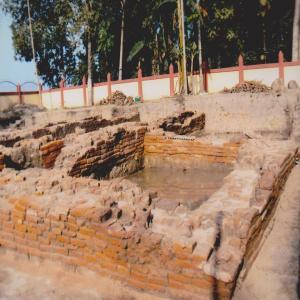 |
(57) Kawaimari Archaeological Site, Kampur, Nagaon District:
Remains of stone temple architecture datable to c. 1100 CE exist here.Stone architectural evidence indicates theerstwhile existence of a Siva temple.
| |
(58) Hatimura Temple, Jakhalabandha, Nagaon District:
The Hatimura Temple is situated on a hillock of massive rock base on the southern bank of the Brahmaputra. The outcrop of rocks at this site is galore. In one of these a rocks is carved a figure of Ganesa. A rock-cut figure of a dasabhujaDurga is to be found on the hilltop along withthe Hatimura brick temple constructed during the reign of the Ahom king Swargadeo Pramatta Singha (1744-1751 CE). The site is surrounded by the Brahmaputra in three directions and as such has panoramicnatural beauty. Being located in isolation, visitors to this temple get momentum during festivals.
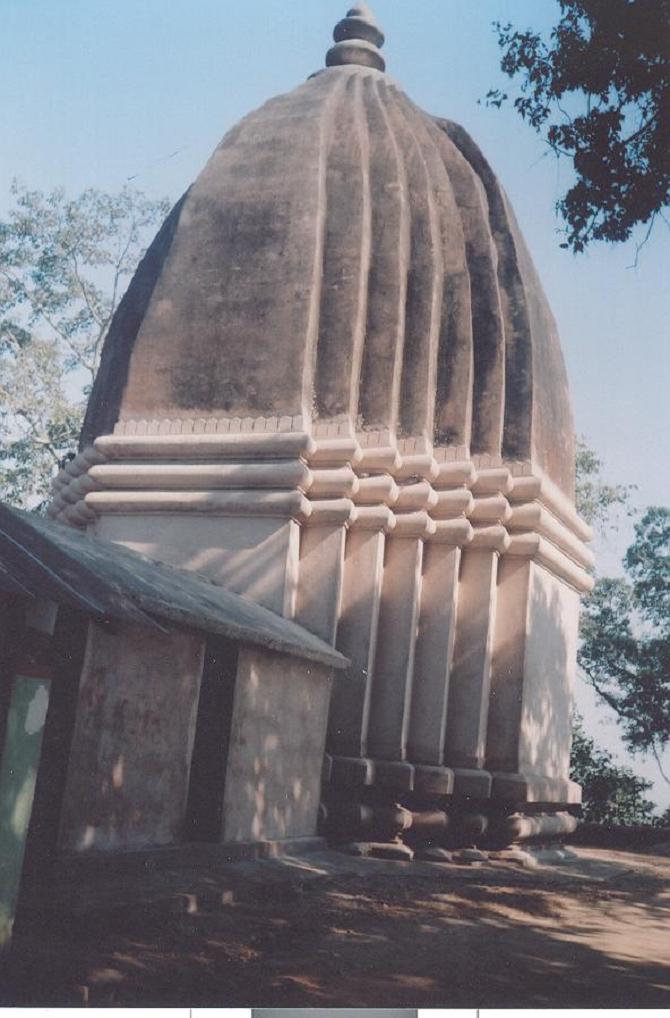
(59) Na-Nath, Archaeological Site, Kenduguri, Nagaon District:
This is situated on an old water channel to the west of the Rajbari and Sankhya Devi Archaeological Sites. The site has eight brick temples divided in symmetrical plan facing each other in two lines. The temple structures have components of stone pillar posts, bases, door jambs, doorsills, Siva linga and Yonipith.
This group of brick-built temples are unique in Assam for these structures have been found embellished with terracotta plaques laid horizontally on the outer face of the walls. The variety of representation includes diverse aspects of nature, figures of gods and goddesses, human and animal figures, floral designs, scenes from public life, religious life and other aspects -all carved to decorate the brick temple walls.
Such decorative arrangements in walls of temples as seen at NathArchaeological Site recalls artistic development of temple architecture during the Gupta period. Judging by the style, these pieces of archaeological evidence at Na-Nath can be dated to c.800 CE. The eight brick built Siva temples with one at Kenduguri nearby make altogether nine temples for which the site is known as Na-Nath.
| | |
(60) Maudanga Ruins, Maudanga, Nagaon District:
Ruins of a temple, sculptured stone blocks and icons of divine figures are to be found here.
(61) Warigadeng Archaeological Site, Nagaon District:
Numerous remains of brick architecture exist in this site.
(62) Sibpur Ruins, Sibpur, Nagaon District:
Remains of two stone temples exist in the form of mounds.
(63) Gachtal Archaeological Site, Dabaka, Nagaon District:
Gachtal Archaeological Site has two stone temples dedicated to Siva There is evidence of agarbhagrha and mandapa with at least four doorways. The carvings on the door lintels and jambs consists of Ganesa, worshippers, a figure of Siva standing with a rosary in the right and a trident in the left hand, water vases flanked by vyalas, elephants, flowers, foliage, animals, twisted serpents and vases placed on amalaka. Figures of Saivite characters such as doorkeepers holding sula and pasa are notable. The evidence indicates development of stone temples at the site during 10 -11th century CE. A stone inscription datable to c.1200-1300 CE has been recovered from this site.
| |
(64) Mikirati Archaeological Site, Dabaka, Nagaon District:
Mikirati Archaeological Site has at least ten brick mounds containing evidence of brick temple structures in them. One such brick mound unearthed by the Directorate in the years 2005-06 reveals the brick-built plinth of a temple with a pranala. The evidence is datable to c. 700 – 800 AD. The other brick mounds remain yet to be explored.
The site has evidence of a stone temple. The stone sculptures and temple relics of Mikirati display a lingering trend of Indian Classical Art. Native cultural belief and practices also manifest in the expression of art. A temple plinth with its mandapa and garbhagrha with a linga and yonipith are found here. These pieces of evidence point towards the development of a stone temple architecture since 10th-11th century CE.
(65) Akashiganga Archaeological Site, Parokhowa, Nagaon District:
Remains of about three temple exist at Akashiganga Archaeological Site. Akashiganga is a rocky spot on a stream surrounded by forests. The beauty of the site is enhanced by a waterfall locally called Akashiganga and this waterfalls serves as a natural picturesque background for the temple ruins. A large section of the stone temple remains have been shifted to an archaeological park and a site gallery installed nearby. Besides numerous fragments, carved temple relics, other evidence of the site include stone pillar capitals, some with carvings, amalakas, door frame, doorsills and jambs, pedestals, horizontal lotus moulded architraves andangasekharas of temples. Figures of Ganas, dancing ganas and floral designs are also to be found here.
The ruins indicate the existence of a Siva temple in the site. Its unique natural beauty, hilly topography and forest attract people and the site remains a place for recreation over the ages.
| |
(66) Kenduguri Archaeological Site, Kenduguri, Nagaon District:
Remains of both stone and brick and evidence of brick temples exist in this site in the form of a mound. The site is yet to be developed.
(67) Devasthan Archaeological Site, Devasthan, Nagaon District:
Devasthan Archaeological Site has atleast nine mounds containing brick remains of temples. Stone temple relics exposed in the site include door jambs, lintels, sculptures, Siva linga and Yonipith. Discovery of stone temple relics in the site suggests that both stone and bricks were used in temple construction. One exposed brick mound has been found with a Siva linga and Yonipith and another with a garbhagriha. Some sculptures of Gods and Goddesses and carved relics of a temple are preserved in a gallery erected on the site, which also houses a tank.
 |
(68) Amtala Archaeological Site, Hojai, Nagaon District:
Here exist ruins of a stone temple stylistically datable to c. 9th - 10th century CE. The site has a pair of historical tanks in the eastern and western directions respectively. During the years 2012-13, the Directorate of Archaeology, Assam, has carried out archaeological excavations in the site and exposed a brick built temple plinth measuring 10 x 13 m. to the north-east of the modern Siva Temple. Further excavation carried out in western tank has revealed stone stairways and a brick embankment and floor.
(69) Gosaijuri Archaeological Site, Dabaka, Nagaon District:
This site has brick and stone temple ruins and also an image of Visnu.
| | |
(70) Bundura Archaeological Site, Kampur, Nagaon District:
Ruins of a stone temple datable to c. 10th -11th CE are found at the site.
(71) Basundhari Archaeological Site, Basundhari, Nagaon District:
The site hasthe image of a rock-cut Ganesa.
(72) Maghnowa Temple, Narayanpur, North Lakhimpur District:
The Maghnowa Temple is situated on the bank of the river Pichala. Constructed during the reign of Swargadeo Pratap Singha (c 1603-1641 CE) it exhibits graceful balance between structural design and decorative treatment.This temple is octagonal in plan and has a rectangularmandapa. The outer wall at the veranda level has a horizontal line of full-bloomed four-petalled lotus and a panel of devokosthas inset with terracotta and stone sculptures of gods and goddesses. These indicate a developed stage of art and architecture under the Ahoms in Assam.The temple has a gateway at the entrance and is surrounded by a brick wall.
(73) Baghar Chukar Doul, Dhakuakhana, North Lakhimpur District:
Baghar Chukar Doul is a miniature brick temple with an octagonal groundplan erected by the Chutiyas. In elevation, the eight vertical walls end in a plainveranda and thereafter each wall tapers into triangular form terminating in a common pinnacle. The height of the temple is roughly 3.50m and its door is of 60cm x 60cm measurement. The size of the door and the inner space of the garbhagriha suggest that the cell was used for the enshrinement of the deity alone. Near to the temple there exists a starred brick altar meant for religious rituals. These structures were constructed by the Chutiyas during the late mediaeval period.
(74) Gosaipukhuri Ruins, Laluk, North Lakhimpur District:
Remains of a stone temple with carved images and relics are found here. Some relics of this temple have been shifted to the Laluk Higher Secondary school and to the PWD resthouse at Laluk. The site has a tank and some temple relics have been preserved in the Nabanagar Club in the locality.
(75) Ghuguha Doul, Dhemaji, Dhemaji District:
Ghuguha Doul is a brick built temple belonging to the Ahom age. It was erected by the Ahom king Siva Singha ( 1714 - 44 CE) in the name of Ambika Devi during the first part of the 18th century CE. The temple is surrounded by a brick wall and two ramparts. A number of tanks excavated and attached to the temple exist here. The West Dhemaji College, West Dhemaji High School and the West Dhemaji Girls High Schools are established on the land belonging to the temple. This is a small temple with a garbhagriha and a mandapa.
| | |
(76) Deoparvat Archaeological Site, Numaligarh, Golaghat District:
This site contains ruins of a stone temple erected upon a monolithic floor. The temple has a ceiling slab engraved with a large lotus bearing a relief of Vidyadhara holding a scarf and a necklace by both hands. A vast range of elegantly sculptured blocks of pre-Cambrian rocks recalling the later Gupta era are to be found here.
The massive door jambs with foliage of drooping petals, encircling creepers with animal and sculptural representation of female door keepers with coronets and huge perforated patrakundalas are other noteworthy finds.
These apart, sculptural representation of kirttimukhas, kala -makaras, panels with carvings of figures depicting episodes from the Ramayana, the Mahabharata, Bhagawata purana are indicative of the growth of a native art and architectural style at Deoparat during 1100-1200 CE
Near to Deoparvat, at Arlongpira, there exists evidence of a sculptor's workshop with evidence of layout of a temple plan in a single line of trial foundation. This indicates the growth of a local craftsmanship and art tradition of temple-building activity in this locality.
| |
(77) No. 1 Dubarani Archaeological Site, Borpathar, Golaghat District:
Ruins of brick-built temples exposed through excavation are preserved here. The site contains mounds of brick temple remains. Of these, three mounds have been exposed. The ground plan of a floor of some structure, a ground plan of a square temple measuring 10 metres in all directions with an outer wall an inner wall and a centrally laid squaregarbhagriha have been unearthed The other mound has revealed the ground plan of a brick temple with a garbhagriha with a Siva linga, a hemispherical object on stone and a dhawaja stambha in it. Layout of an ardhamandapa andtorana or entrance gateway with an outer wall of a temple has also been discovered.
Theremains of a brick temple at No1 Dubarani Archaeological Site indicate the development of a regional architectural pattern of brick-temple architecture modelled along the lines of Gupta temple architecture. The plain and straight walls of the temple are not accompanied by a sikhara but has a flat roof (thatched in this case)- a feature characteristic in the early phase of Gupta architecture.
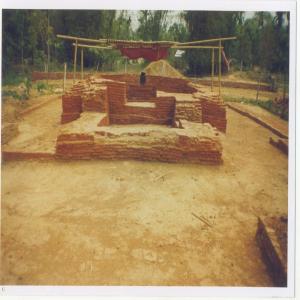
(78) Alichiga Tengani Archaeological Site, Barpathar, Golaghat District:
Alichiga Tengani Archaeological Site is a fortified settlement. The site is square in its ground plan. This site was developed as a setubandha as per the principle of the ancient Indian silpasastras.It has an embankment in the centre found with evidence of bricks which is fortified by a water ditch in four directions except for its two entrances laid in west and east. This site also has a small embankment situated close by. The site was developed as a port or as a harbour duly connected to the river Dhansiri by a system of canals.This indicates the existence of a trade centre under royal administration at this site. An inscribed clay sealing of Sri Vasundhara varmana and a stone slab inscription with the impression of a pair of human foot prints and name of Sri Ratnavarmana have been recovered from here. Both the records have been engraved in brahmi character datable to c.400-500 ACE.
(79) Grave of Bahadur Gaon Burha, Jorhat Town, Jorhat District:
Bahadur Gaon Burha actively participated in the Indian Sepoy Mutiny of 1857. The grave of this patriot of the First War of Indian Independence is located on the road to Jorhat town.
(80) Na-Pukhuri Siva Temple, Rudreswar, Sivasagar District:
The Na-pukhuri Tank lies near the Na-pukhuri Siva Temple which was constructed during the reign of Swargadeo Lakshmi Singha (1769-1780) and consecrated during the reign of Gourinath Singha (1780-1794).

(81) Visnu Doul, Namti, Sivasagar District:
A brick-built temple constructed by Namatial Bhagati Barbarua in the year 1775 CEduring the reign of Swargadeo Gourinath Singha (1780 -1794) exists here. The sikhara of the temple is decorated with vertical and horizontal lines. These lines intersect at angles to provide ornamental arrangements. The walls of the temple represent wooden panels of native Assamese architectural designs. The temple is surrounded by a brick-built enclosure wall.
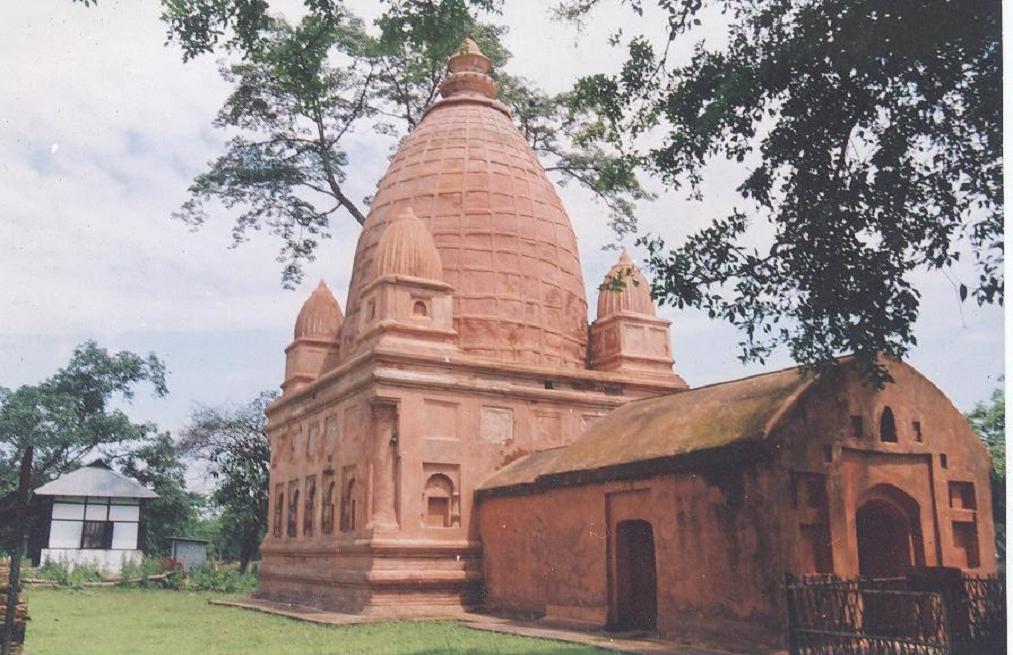
(82) Devi Doul, Namti, Sivasagar District:
A brick-built temple constructed by Namtial Bhagati Borbarua in the year 1775 during the reign of Swargadeo Gourinath Singha (1780-1794) exists here. The sikhara of this temple is adorned with vertical lines and the walls of the temple are modelled on the wooden panels of a Assamese house. The wall of the temple is adorned with terracotta mouldings of lotus.
(83) Sa-Dhowa Pukhuri, Sukafa Nagar, Sivasagar District:
The Sa-dhowa tank is associated with the Maidam located at Charaideo. Literally, Sa-dhuwa means religious washing of the corpse before cremation into the Maidams. This is the only tank bearing the evidence of this practice in Assam and hence, it is historically very significant.
(84) Phakuwa Doul, Joysagar, Sivasagar District:
A brick-built temple constructed during the reign of Swargadeo Rudra Singha (1696-1714 CE) exists here. This is a structure octagonal in plan laid with a series of stairs to its central height and provided with eight angasekharas at plinth level at each eight corners of the structure. The series of stairs of the structure is tapered upward and has a flat platform at the top. Four principal stairs of the structure have been laid in four directions from bottom to the top of this structure where a temple was erected.
It is a pyramidal architecture bearing the characteristic style of the steppedarchitecture Chichen Itza of the Mayan Civilization datable to 600 CE located in the Yucatan Peninsula in Mexico. Stylistic features of this structure resemble certain South-east Asian monuments such as Borobudur of east Java.
(85) Hara Gauri Temple, Joysagar, Sivasagar District:
This is a brick-built temple constructed during the reign of the Ahom king Swargadeo Rajeswar Singha (1751 – 1769 AD). It is a small do-chala structure. The temple is profusely ornamented, with the upper part of the outerwall containing floral designs.
The walls are designed like the panels of wooden Assamese houses. Posts of the architecture project outside in the shapes of wooden posts of Assamese houses. It may be that this temple was earlier erected with wood and bamboo and was later redone with bricks.
| | 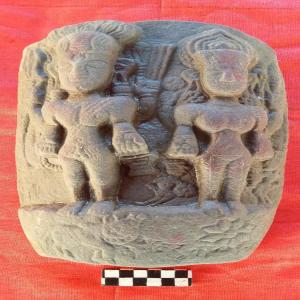 | 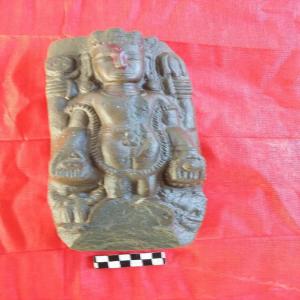 |
(86) Gorokhiya Doul, Nazira, Sivasagar District:
Gorokhiya Doul is a brick-built temple constructed during the reign of the Ahom king Swargadeo Pratap Singha (1603-1648 CE). It is one of the early temples constructed by the Ahoms.The temple is small and octagonal in plan and has a stunted sikhara. Also known as Mai Doul or Maheswara Ghar or Puja Sil, the Garakhiya Dol represents the earlier phase of development of temple architecture of the Ahoms. The outer walls of this structure bear two horizontal rows of devakosthas. This temple is a simple structure.
(87) Barpatra Gohain Dol Pukhuri Archaeological Site, Bethbari, Sivasagar District:
During the reign of the Ahom King Rudra Singha, (c.1696-1714 A.D.) Chengkong Borpatra Gohain-a descendant of the royal minister of Kenduguria Borpatra Gohain family-had excavated the tank at Kenduguri. He went on further to construct the Siva Doul, Vishnu Doul and Devi Doul at the northern bank of the tank which are known as the historic Borpatra Gohain Doul.
(88) Piyali Phukanar Doul, Geleki, Sivasagar District:
Two brick-built temples dedicated to Siva and Vishnu existed at the site believed to be constructed by the historical Rangachila Duarah family of this locality,to which martyr Piyali Phukan belonged to. This temple was surrounded by a brick-built wall and possibly had a torana. At present however only one temple is in existence. The temple has a number of stone sculptures of the early period.
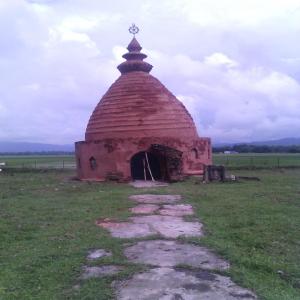
(89) Thoura Doul, Rajmai, Sivasagar District:
This temple with brick decorative tiles was constructed by Alan Burha-Dihingia Barbarua in 1683-85 CE during the reign of Ahom king Gadadhar Singha (1681-1696 CE). A tank attached to the Thoura temple, believed to be one of the earliest tanks excavated during Ahom rule, is to be found here.
 | 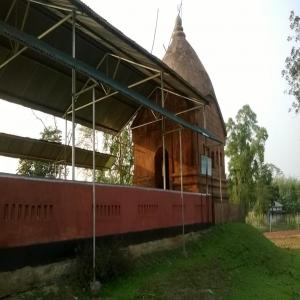 |
(90) Visnu Doul, Kalugaon, Sivasagar District:
A brick-built temple constructed by Harinath Barpatra, a brother of Queen Phuleswari during the reign of Siva Singha (1714 -1744 CE) exists here. Stone sculptures depicting the dasavatara incarnations of Visnu are fixed in the devakosthas (niches) of this temple.
(91) Jagaddhatri Doul, Kalugaon, Sivasagar District:
The Jagadhatri Doul is a brick-built temple constructed by Harinath Bar Patra, a brother of Queen Phuleswari during the reign of Siva Singha ( 1714 -1744 CE). This is a sakta temple of the Ahom age and a number of sculptures are found laid in the devakosthas of this temple.
(92) Borpatra Tank, Kalugaon, Sivasagar District:
This is a large royal tank excavated by the Ahom Queen Ambika Devi during the Ahom period. It is attached to the Jagaddhatri temple of the site.
(93) Gallows Site of Piyali Phukan, Sivasagar, Sivasagar District:
Piyali Phukan, the son of Badan Barphukan was publicly hanged in this spot at the north-eastern corner of the historical Sivasagar tank in 1830 CE by the British rulers. A memorial park with a memorial column commemorating the name of this patriot stand here. He was the first martyr of Assam during British rule.
(94) Charaideo Maidams, Sukafa Nagar, Sivasagar District:
Charaideo- a sacred place of the Morans and Barahis- bears the memory of the Ahom kings. It was here that Sukafa, the first Ahom monarch set up his permanent capital in 1253 CE, which continued to remain, as such till the region of King Tyao Khamti (1380-1389 ACE). Charaideo can be divided into three principal areas: the capital area, the cemetery area and the sacred area. Through no structural evidence remains of the capital area at present, the remains in the cemetery and religious areas are still to be seen. It was here that members of the royal Ahom families as well as the high-ranking officers were buried according to Ahom customs and rituals. Through it is not possible now to identity as to which burial maidam belonged to whom in view of the absence of materials as well as documentary evidence, tradition assigns some of the maidams to particular ruling Ahom monarchs and their consorts.
Charaideo Archaeological Site is the sacred royal burial abode of the Ahom monarchy. The site is situated on the Sivasagar Sonari Road, in Charaideo Division of Sivasagar District.
The burial mounds are called maidams and the site covers 750 bighas of land and approximately 3500 m in radius. Proposed developmenttook the form of regulating the inflow of touristsby introducing an entry feeto the site and putting a check onunauthorized earth-cutting within the heritage zone by providing a permanent brick boundary wall in the entire area.

(95) Bogi Doul, Meteka, Sivasagar District:
This site has a foundation of a broken brick temple constructed during the reign of Swargadeo Lakshmi Singha (c.1744-51 CE). The temple wasa brick Siva temple. The temple collapsed during the earthquake of 1897 and the foundation and parts of sikhara of the brick temple lie here on the bank of a tank historically attached to this site.
(96) Golaghar, Garhgaon, Sivasagar District:
This is a magazine house of the Ahom age. Garhgaon was once the capital of the Ahom kingdom and the Ahom rulers used this monument as a Magazine house to store arms and ammunitions.
(97) Lunkuri Doul, Doulbagan, Sivasagar District:
Relics of an old brick built Siva temple of Gadadhar Singha's time exist here.
(98) Darika Silsako, Simaluguri, Sivasagar District:
The Darika Silsako is built over the Darika River. The bridge stands on four pillars. The foundations of the pillars are made of dressed stone blocks. The upper surface of the bridge is slightly carved and there are five arches made up of thin lakori bricks with lime surkhi mortar in the lower part of the bridge adjacent to the pillars. The breadth of the bridge is 12 feet 13 inches, the length 109 feet 2 inches and the height 18 feet 5 inches. The bridge was constructed during the reign of Swargadeo Pratap Singha (c.1603-41 CE).
(99) Kenduguri Silsako, Kenduguri, Sivasagar District:
The Kenduguri Silsako is built over the Dijoikona River at Kenduguri. The bridge stands on two pillars. The foundations of the pillars are made of dressed stone blocks. The upper surface of the bridge is slightly carved and there are three arches made up of thin lakori bricks with lime surkhi mortar adjacent to the pillars. The breadth of the bridge is 13 feet 5 inches, the length 78 feet 5 inches and the height 15 feet 5 inches.
(100) Barbarua Maidam, Lukwa, Sibsagar District:
The Barbarua was an officer in the medieval period who was the Ahom governor of Eastern Assam, i.e. of the territories east of Kaliabor.
(101) Bhojo Warfare Site, Sonari, Sivasagar District:
This site was used as a training centre for Guerilla warfare tactics by the Ahoms in the medieval period. The area covers about 129 bighas of land. The site comprises of numerous man-made earthen mounds which lie 90-100 cms apart from one another. The height of the mounds varies from 1.10 metres to 1.20 metres. Evidences of some trench-like cavity are also to be seen on the site.
(102) Gargaon Rampart, Nazira, Sivasagar District:
The Ahom king Siuklen-mong (c.1539-1551 CE) or Garhgonya Raja built the capital city of Ahom at Gargaon in c.1540 CE. He fortified the city in all directions by erecting earthen ramparts and dug up moats as a deterrent to foreign invasion. There are four gates to enter the Gargaon city. The shape of the city is apparently rectangular.
(103) Raidongia Doul, Kalakhowa, Dibrugarh District:
Raidongia doul is a brick-built Devi temple constructed during the reign of the Ahom king Swargadeo Pramatta Singha (1744-1751 CE).
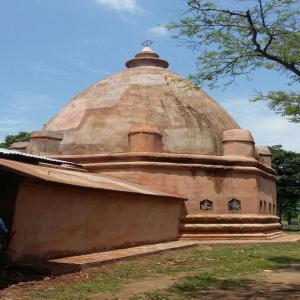
(104) Moiramora Doul, Khamtighat, Dibrugarh District:
Moiramara Ruins is situated on the bank of the Dihing at Khamtighat. The site has stone sculptures of different postures and attitudes datable to the early and late mediaeval period. The sculptures bear native ethnic texture.
(105) Bezor Doul, Dimou, Dibrugarh District:
Here exists a brick-built temple having an octagonal garbhagrihawith a narrow antaralaattached to it, datable to the late mediaeval period of Ahom reign. A traditional medicine practitioner of Ahom kingdom (Bez), who belonged to the 'Chung khel', got promoted from Bez to Bezbaruah for his excellent medical treatment to the Royal family. He received a large area of land from the Ahom king at the present day Bezor Pathar area, where he went on to construct the Bezor Doul.

(106) Borganga Rock Inscription, Dokmoka, Karbi Anglong District:
The Barganga Archaeological Site is situated in Barganga village at a distance of about 3 kms to the south of Dokmoka in Karbi Anglong district. The evidence of a temple of large dimensions with three structural components – the garbhagriha,ardha mandapa and a mandapa-exists here.The garbhagriha of the temple is built of stone while the mukhamandapa andmandapa are made of bricks. The site has a series of rocks and evidence of rock-cut sculptures and brick remains.
One of the rocks of the site is engraved with an inscription in four lines. The epigraph records the establishment of an asrama or a hermitage during the reign of Bhutiavarmana who ruled in c.600 CE.The site also has sculptures of dwarapalas, a door jamb, a gajavyala, a human figure playing a musical instrumentamong others. These are stylistically datable to c.1100 CE.
(107) Ruins at Sarthe Rangphir Gaon, Phuloni, Karbi Anglong District:
Sarthe Rangpha Gaon has evidence of the layout of a fortified settlement with tanks, ramparts and ditches. The site also has evidence of a stone temple of large proportions as seen in carved stone fragments bearing carvings of lotus, besides the layout of a plinth of a stone temple. Natural lay of the area reflects that this was a site of early settlement. This site was probably a centre through which passed communication routes connecting it with other sites in the Kapili-Jamuna valley. Sarthe Rangpha Gaon has evidence of an ancient settlement upon an elevated area surrounded by a paddy field.
(108) Burhagosain Than, Dokmoka, Karbi Anglong District:
Burhagosain Than has stone temple relics stylistically datable to c.1100 CE. These include a number of chiselled and carved stone components, fragments of old bricks and a river ghat surrounded by a brick boundary wall. A modern temple shed has however been built upon the old cell floor with theSivalinga at its centre which is intact. The site has brick structural evidence at the riverghat which suggests that a riverwharf flourished at this site.
(109) Rock-cut Durga, Tilapara, Langhin, Karbi Anglong District:
This rock-cut Durga at Tilapara is located on the Diphu-Dimapur Road at a distance of 20 kms from Langhin in Karbi Anglong. The name Tilapara means a mound on which the rock-cut figure of a Durga exists surrounded by a village settlement. One of the rocks of this hillock contains a rock-cut figure of dasabhuja Durga provided with a rounded niche of 10 cm depth. The relief is provided with a squarish face with a flat type headgear with three equidistant projections.It wears puspakundala and akanthahara.To the left is a motif of a lion, the celestial vahana.Her right arms hold a khadga and a trisula with its tip piercing the Asura. Her left arms hold a pasa and an indistinct object.The deity is carved in the posture of killing Mahisasura with her trisula.This rock-cut figure is stylistically datable to c.1000 AD.
(110) Rock-cut Ganesa, Boga Doul, Langhin, Karbi Anglong District:
Bogadoul Archaeological Site has a rock-cut caturbhuja figure of Ganesa seated on an asana. The figure holds a japamala, an ankusha, a trisula, and a fruit. The head of the Ganesa is decorated with a jatamukuta. Remains of old bricks are seen at the site,which indicate the possibility of the existence of a brick structure.
(111) Metha-long-e, Donkamokam, Karbi Anglong District:
The site has a group of monoliths known locally as Metha-long-e. The group has atleast 25 monoliths.The height of the taller monoliths ranges from 3.50m to 5.10m. The monolithic columns indicate the lingering megalithic tradition of worship of the souls of the dead for prosperity among the native community.

(112) Ruins at Chikari Rongpi Gaon, Langlokso, Karbi Anglong District:
The remains at Chikari Rongpi Gaon indicate the existence of a small stone temple of exquisite beauty. Few relics from the site have been preserved in a modern temple shed at Dentaghat.
(113) Tanks and Rampart, Maibong, North Cachar District:
The site has a brick rampart of 1 km length extending upto river Mahur in west and hill range in east. Maibong was the capital of the Kacharis who had erected this rampart for the fortification of their settlement area. The site has two royal ponds with brick embankments known as Raja pukhuri and Rani Pukhuri. Of these, one tank is 14 m in width and the four banks have masonry flights of steps made of bricks from its bank to the bottom of the tank. The other brick tank Raja Pukhuri is rectangular in plan.
(114) Shiva temple, Shivtila, Cachar District:
Two brick temples with inscriptions built during the time of the Dimasa king Krishnachandra exist here. The temples are squarish in ground plan and elevation and raised on brick platforms.
| | |
| |
(115) Old Brick Building, Moina, Karimganj District:
This is a brick built building of late mediaeval period. The building is rectangular in plan and elevation and has a number of false windows fashioned as a means for decoration of the structure. The walls also have floral designs employed to decorate the building.
| |
(116) Gaurivallabh Devalaya, Sivasagar District:
The Gaurivallabh Devalaya was constructed in c.1774 CEduring the reign of the Ahom King Lakshmi Singha. The elder son of Ramananda Arachrya constructed the brick-built temple in memory of his father. Ramananda Arachrya was known as Na-Gosain, so, Gauriballav Devalaya is also known as Na-Gosair Doul.
The temple consists of two segments viz, garbhagriha and antarala. The garbhagriha is surmounted by a chow-chala type of sikhara, with four angasikharas while the antarala has a do-chala type of roof.
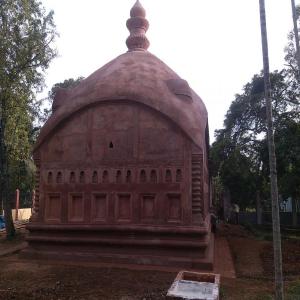
(117) Lithapana Maidams, Sivasagar District:
